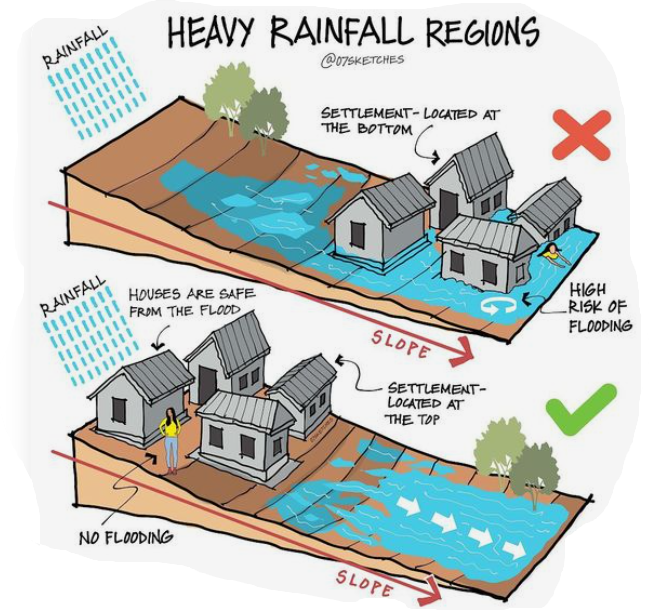Search This Blog
Most Popular
Categories
- Building Construction (87)
- Building Materials (85)
- Columns (2)
- Concrete Beam (3)
- Concrete Construction Techniques (6)
- Concrete Mix Design (14)
- Concrete Repair (14)
- Concrete Slab (11)
- Construction Equipment (17)
- Construction News (7)
- Design of Structures (18)
- Engineering Drawing (1)
- Estimation (3)
- Geotechnical engineering (26)
- Highway Engineering (11)
- Innovations (34)
- Material Testing (11)
- Matrix Analysis of Structures (2)
- Mechanical Engineering (3)
- Strength of Materials (2)
- Structural Analysis (13)
- Structural Design (24)
- Structures (17)
- Transportation Engineering (9)
Grading a Construction Site | A Beginner's Guide
Team Prodyogi
October 11, 2023
Every construction project starts with preparing the site for construction. This preparation of the land is what we define as construction grading or so-called site grading. The construction site can be graded levelled or sloped based on the requirements of the project.
In this article, we will discover construction grading, its types, importance, and its construction features.
The primary objective of construction grading includes:
Construction site grading is the crucial first step in any project, shaping the land for proper drainage, stable buildings, and aesthetic appeal. It ensures safety, efficient land use, and environmental protection while benefiting neighboring properties. In essence, it's the foundation for a successful construction project, promoting sustainability and community well-being.
In this article, we will discover construction grading, its types, importance, and its construction features.
What is Construction Grading?
Construction grading or site grading is defined as the process of preparing the site for a project either by raising or lowering ground levels, adding or removing slopes, or leveling the ground surface.The primary objective of construction grading includes:
- To provide a proper drainage system for the site
- To achieve desired aesthetics
- To prevent soil erosion
- To comply with building codes and regulation
 |
| Grading for Drainage & Flooding Issues |
Types of Site Grading
Depending on the construction requirements, different types of site grading are performed. This includes:
1. Landscape Grading
Landscape grading basically involves the removal of topsoil, modification of slope, implementation of the drainage system, smoothening soil for plants, or changing the appearance of the land. This is mainly performed for irrigation and gardening applications.
2. Architectural Grading
Architectural grading involves changing the entire contours of the landscape for better drainage and to achieve a level base for building a new residential or commercial property.
3. Rough Grading
Rough grading is the process of preparing the construction site to understand its topography for future work. This is done before the final grading process. The process involves the removal of vegetation, cleaning debris, and leveling the soil to create a stable base for construction.
4. Regrading
Regrading is defined as the process of lowering or raising the land level as per the requirement. It is used for both small and large projects.
5. Finish Grading
Finish grading involves fine-tuning the topography of the site to ensure the drainage is proper, and the functionality of the site. It is done after rough grading and before final grading.
6. Final Grading
The last step in construction site grading is the final grade. Final grading involves finishing the surface with a material like sand. This is mainly performed in landscaping works to promote plant growth.
Benefits of Construction Site Grading
Site grading is necessary because it influences construction safety, project results, and the overall impact on the environment. A properly graded site helps to avoid structural instability due to foundation settlement, and flooding issues. It is not just a need for our site, but also for the neighboring properties as well. Let's discuss the importance and benefits of construction grading in detail.
Proper Drainage
Grading a site facilitates surface runoff preventing pooling. A grading slope that helps the water flow away from the property to a safe exit does not damage landscaping or attract mosquitos. It also helps prevent structural damage to your and neighboring properties due to water flooding.
Effective Land Use
Land is expensive and it is important to utilise every bit of it the best way you can. The presence of a slope can make that portion of the land unusable. Grading would help transform the slope into a grade that can be used effectively.
Stability of the Building
The stability of all the buildings lies in the foundation. Proper land grading allows for a solid foundation. Thus the structure's base is more steady and ensures more structural integrity. Improper grading and compaction may result in sudden collapse of soil failures.
Aesthetics of the Site
A structure placed on uneven land is less aesthetically pleasing and has logistical issues compared to one constructed on a smooth land area.
Read More: 25 Top Heavy Equipment Used in Construction
Most Visited
Soil Sampling Methods| Undisturbed and Disturbed Samples
November 08, 2023
Boring Methods for Soil Exploration
November 02, 2023
What are Infiltration Wells?
April 15, 2024
Steel Column Connected to Concrete Masonry Wall
October 11, 2017
How to Choose Good Quality Aggregates for Construction?
August 10, 2021
Terzaghi's Equation: Soil Bearing Capacity for Foundations
March 02, 2022
Structure of Timber |Macrostructure and Microstructure
March 22, 2024
Search This Blog
MUST READ
What is PERT? Objectives, Pros & Cons
September 10, 2017
Terzaghi's Equation: Soil Bearing Capacity for Foundations
March 02, 2022
Contact Form
Footer Menu Widget
Created By SoraTemplates | Distributed By Gooyaabi Templates


0 Comments
Commenting Spam Links Are Against Policies